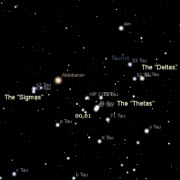In the first of this two-part feature we shall take a look at some of the celestial winter wonders located in or near the asterism sometimes referred to as the Celestial “G”, whether using the naked eye, binoculars or a telescope.
But first let us familiarise ourselves with the celestial “G”. This large asterism encompasses much of the southern aspect of the winter sky, incorporating the brightest stars visible there, which form a large, slightly tilted in aspect, capital letter ‘G’.
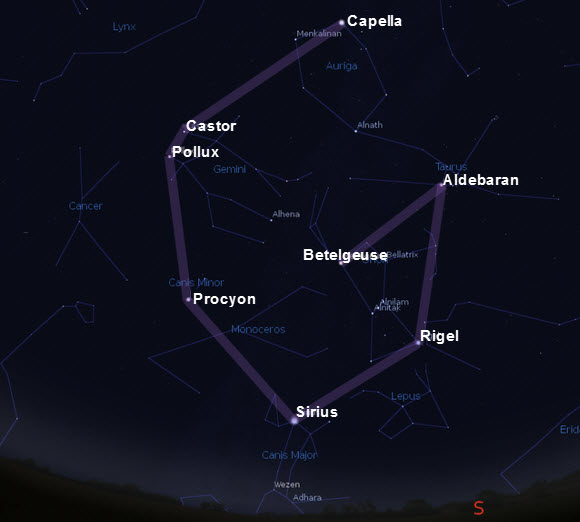
The Celestial G, connecting Aldebaran, Capella, Castor and Pollux,
Procyon, Sirius, Rigel and Betelgeuse.
We shall start at “ruddy” Aldebaran (the eye of the bull) high up in Taurus. Aldebaran appears to be a member of the “V” shape Hyades cluster, but is in fact a fake, lying at half the distance of the true members, which are approximately 120 light years distant.
Zeta Tauri and the Crab
Nebula (Image: ESA/Hubble)
The Hyades are a good example of a loose open cluster, and are best viewed through binoculars. Not far from the Hyades, the smaller, but more beautiful Pleiades open cluster really attracts attention. This cluster is a gem when viewed in binoculars and breathtaking if your scope comes with a really low power eyepiece. The Pleiades is a good example of a young star cluster – thought to be around 150 million yrs old, it lies 410 lys away.
Taurus also contains one of the very few supernova remnants visible to smaller instruments - the Crab nebula or M1. This remarkable object lies close to zeta Tauri – the southern horn, and is visible as a misty patch when viewed though a scope. In 1054 however, this cataclysmic stellar death briefly outshone all other objects in the sky and could be seen in daylight.
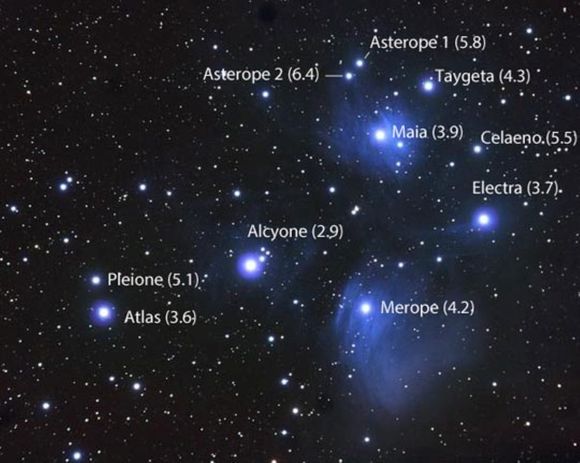
The Pleiades in Taurus
Return to Aldebaran and travel up to the zenith - the point overhead. The bright star visible is Capella in Auriga. This constellation contains 3 open clusters (M36, M37 & M38) all visible in binoculars but all are best viewed with a scope. All three are over 4,000 light years distant.

M36, M37 and M38, near Capella in Auriga
From Capella travel down in a S.E direction to locate the “twins” of Castor and Pollux, chief stars in Gemini.
Castor can be readily split into two components with most scopes, but it is a much more complicated system with at least 6 members comprising the star we see.
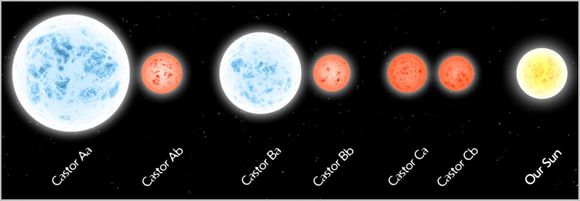
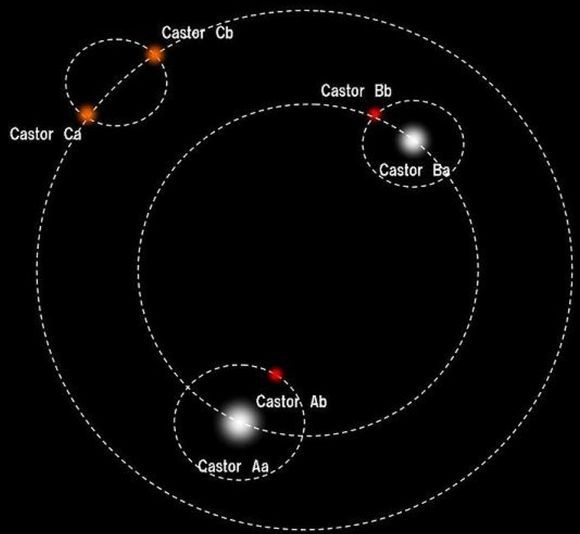
Castor System (bottom, image: unknown) and
the relative sizes of its components (top, Image: NASA Artist)
At the opposite end of the constellation, close to the star marking Gemini’s left foot (the uppermost as we look) resides one of largest open clusters visible, M35. Through binoculars it appears as a grainy haze of light, while in small scopes at low/med magnification it resembles a spectacular swarm of faint stars.
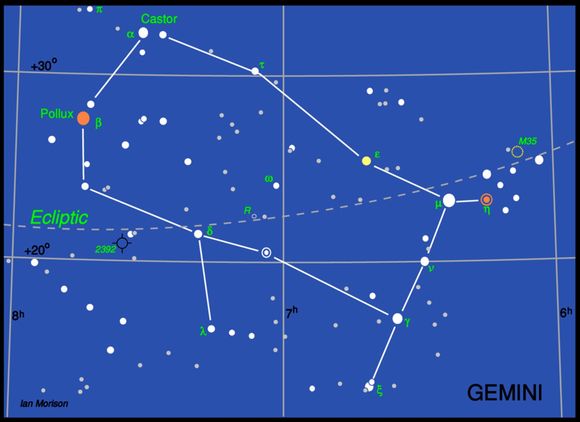
Gemini Finder Chart (Image: Jodrel Bank/University of Manchester)
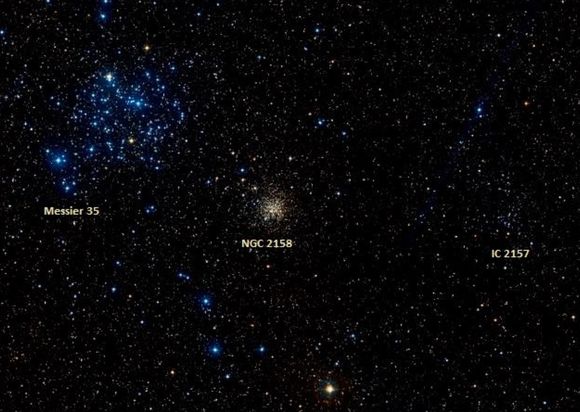
M35, NGC2158 and IC2157 in Gemini (Image: NASA)
Our next “G” star is Procyon the bright star below Gemini in the constellation of Canes Minor.
Procyon sits close to the Milky Way - the ribbon of light from countless stars marking a spiral arm of our galaxy. Sweep this area with binoculars or low power and you will be awe struck by the sheer number. Next hop across the milky stream and continue down to the S to find the brightest member of the “G” and the brightest star in the night sky - Sirius in Canes Major.
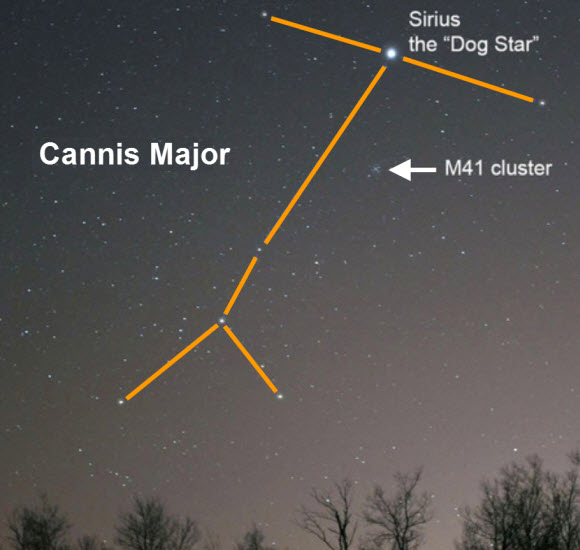
Sirius in Cannis Major, and the M41 Cluster (Image: Astro Bob)
Viewed through any instrument, Sirius resembles a dazzling diamond flashing all colours of the rainbow - no your optics are not faulty (hopefully) this is due to the turbulent, denser part of the Earth's atmosphere we all have to peer through. A binocular field below Sirius lies a beautiful open cluster M41 which is surrounded by a rich field of background stars.
Our last port of call is the majestic constellation of Orion. First travel across to brilliant blue-white Rigel at the foot of Orion - brightest of the many young massive stars found in this region which formed from the same giant molecular cloud tens of millions years ago. Now sweep up to the three belt stars of Orion, below which, in the sword of Orion sits a celestial marvel - the Orion nebula, M42. This huge nebulosity is our closest stellar nursery, some 1250 light years distant. At its centre sit the hot young massive Trapezium stars - the bully boys of this crèche.

Betelgeuse star placed at the centre of our Solar Sytem, showing orbits of the planets.
(Image: Karl Schwarz?)
This is one object worth viewing over and over again, use different powers to highlight different aspects. The nebulous extension of M43 lies just to the N of M42. Completing the “G” is the red super giant star Betelgeuse, marking the right shoulder of Orion. Betelgeuse is a behemoth of a star, perhaps 400million miles in diameter, but now extremely tenuous. It shines at the other end of the stellar evolutionary scale, a star whose life is heading towards an explosive finale sometime within the next 10,000 yrs. When Betelgeuse does go supernova, wow, will it be a sight to behold. Put it on your Christmas wish list!
- Log in to post comments

